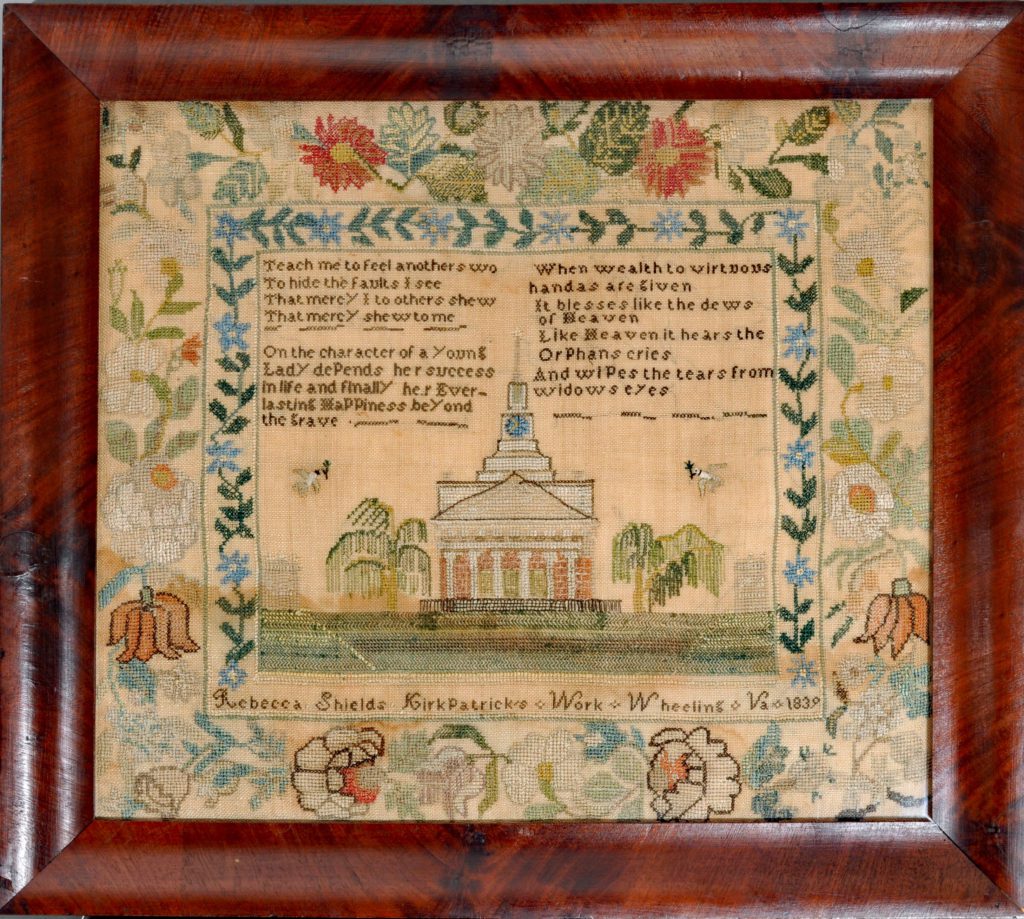Samplers: The Artwork of Children
By • July 11, 2018 0 4284

In 18th- and 19th-century America, samplers were used as an educational tool for girls from all social backgrounds, but the function of the finished product would differ.
The proud parents of a girl from an affluent family might put her sampler in a wooden frame and hang it on the wall to show her skill in needlework, good upbringing and domesticity. It also communicated that a girl’s parents were wealthy enough to send their daughter to school and that the family valued the arts of refinement.
However, the sampler of a girl who was a charity school student would prove to potential employers her ability to sew, mark and mend personal and household linen.
A middle- or upper-class girl was expected to grow up, get married, have children and take care of a home. Proficiency with needle and thread was not a hobby back then; it was a necessity. As part of her preparation for the responsibility of sewing clothes and linens for her future family, most girls completed at least two samplers.
Regardless of the social class of most sampler stitchers, the techniques were often similar. Samplers demonstrated an ability to do simple embroidery techniques, plain sewing techniques and darning. Plain linen cotton and wool were the usual ground fabrics.
Marking samplers with her initials in cross-stitch served a dual purpose. It taught the child basic embroidery techniques and the alphabet and numbers and would help the homemaker keep track of her linens, some of her most valuable household goods.
The charity school movement began in 18th-century England at a time when growing numbers of children were destitute due to a rising population and rapid urbanization. In
Philadelphia, the Charity School for Boys, spearheaded by Ben Franklin and William Shippen, opened in 1751. A branch of the school for girls followed in 1753. It was believed that teaching needlework benefited girls from impoverished backgrounds since it prevented idleness and gave them employable skills.
Girls could start sewing as young as 5 or 6, as long as they could hold a needle and a piece of fabric. They might make their first sampler at age 8. Many of these charity school samplers tended to be simpler, more practical examples of needlework, used within the school or sold to benefit the school and sometimes the stitcher.
A girl lucky enough to continue her education usually made a second, more intricate, decorative pictorial sampler at a ladies’ boarding school while she was in her adolescent years. Due to the regional differences in these schools, experts can often assign a sampler to a region — or even to a particular school — by the style of stitching and design
elements. Commonly, alphabets and rows of numbers were stitched in. Buildings, animals, trees and borders of flowers and vines were often included as well.
Samplers and pictorial embroideries created by girls and young women are a valuable insight into the social history of women’s culture and education in the 17th, 18th and 19th centuries. In addition to showcasing a girl’s domestic talents, decorative samplers also revealed the values of the girl and her family to potential suitors. The verses found on many samplers emphasized the importance of female virtue, the value of education and obedience to one’s parents and to God.
The acceptance of death and the remembrance of the dead, including the sampler maker herself, is another frequent theme. Girls usually signed their samplers, stitching their name, their age and the date when the sampler was completed. Dealers and collectors prefer them signed and dated.
In 1921, the National Society of the Colonial Dames in the Commonwealth of Massachusetts published “American Samplers,” researched by members Ethel Stanwood Bolton and Eva Johnston Coe. Listing 2,500 samplers, the book is still considered to be the most comprehensive resource for samplers and pictorial embroideries. A section of the NationalSociety’s website continues the documentation, locating those samplers listed in the book and adding others as they are found. If you own a sampler or a pictorial embroidery stitched before 1900, you can visit the site, click on the sampler survey form and join in this valuable project.
Framed American schoolgirl samplers can fetch hundreds, even thousands of dollars, providing they are in good original condition, colorful and graphically pleasing. Schoolgirl needlework is unique among the things we collect in that it is the work of young girls, and the work typically stops when the girls grow up. To collect and study these works is to always collect the early years; there is no middle or later period, no mature work and, most often, not even more than one. Putting them in a historical context illuminates issues of gender and education in the 18th and 19th centuries.
A young woman’s sampler was her mark on the world — the pinnacle work of her education. These small bits of embroidered cloth are often all that remains to testify to the otherwise unrecorded lives of their makers.
Based in Georgetown and in Washington, Virginia — where her shop, Antiques, Whimsies & Curiosities, is located in Hazel River Antiques on Lee Highway — Michelle Galler specializes in American primitives and antique folk art. Reach her at antiques.and.whimsies@gmail.com.

